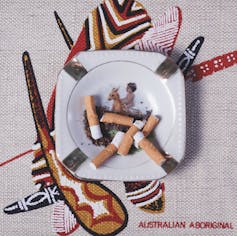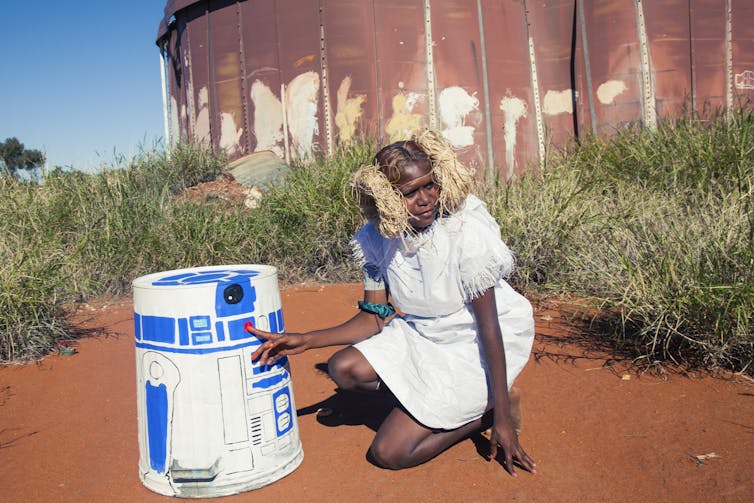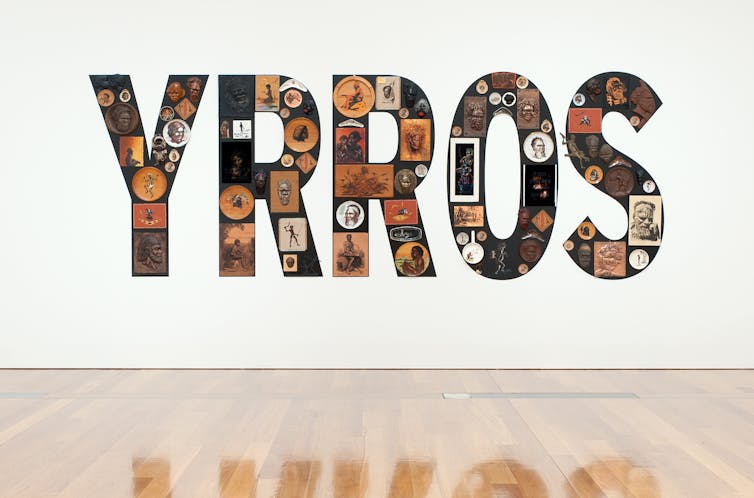Tony Albert’s politically charged kitsch collection confronts our racist past
- Written by Chari Larsson, Lecturer of art history, Griffith University
The collector dreams his way not only into a distant or bygone world but also into a better one.
-Walter Benjamin, The Arcades Project.
Seeking exile from the growing anti-Semitism in his native Germany, author Walter Benjamin’s words are just as relevant today as they were when he wrote them in the early 1930s. Living in Paris, Benjamin loved rifling through what he saw as capitalism’s ruins in the fusty and out-dated 19th-century arcades, delighting in the mass-produced detritus that he found in secondhand shops. Freed from what he described as the “drudgery” of being useful, Benjamin’s objects were transformed by the act of collecting and acquired a quasi-magical status.
 Tony Albert.
Girramay/Yidinji/Kuku Yalanji peoples
Australia Qld/NSW b.1981
Child Riding Kangaroo (from ‘Mid Century Modern’ series) 2016 Pigment print on paper
100 x 100cm
Collection: The artist. Courtesy: Sullivan+Strumpf, Sydney
Tony Albert.
Girramay/Yidinji/Kuku Yalanji peoples
Australia Qld/NSW b.1981
Child Riding Kangaroo (from ‘Mid Century Modern’ series) 2016 Pigment print on paper
100 x 100cm
Collection: The artist. Courtesy: Sullivan+Strumpf, Sydney
Like Benjamin, Tony Albert is the quintessential collector. A descendent of the Girramay, Yidinji and Kuku Yalanji people, he has carefully scoured thrift shops for what he calls “Aboriginalia”: the kitsch caricatures of Indigenous people adorning trays, tea towels, playing cards, spoons and even pinball machines from the 1940s to the 1970s.
Albert reassembles these vintage objects, creating poignant displays of memorabilia. Each individual object contains its own memories and stories. In this way, Albert holds a mirror up to our own collective memory and reminds us that this is the stuff, the matter, that forms the substrata of contemporary Australia.
To place collective memory under scrutiny is not easy and hence the significance of Albert’s new survey exhibition, Visible, at Brisbane’s Queensland Art Gallery. It was the conspicuous absence of Indigenous representation in visual culture that initially drew Albert as a child to secondhand shops in the 1980s.
By making the invisible visible, Albert stages a direct confrontation with Australia’s difficult and racist not-so-distant past. Akin to Benjamin’s quirky assortments of stamps and snow domes, new meanings are acquired through Albert’s reassembling of disparate objects into a collection. What comes to the fore in the show is how deftly he traverses mediums, moving from his iconic text-based assemblages of the 2000s to photography, installation and newly commissioned sculptural work.
Mid Century Modern is a 2016 series continuing Albert’s reactivation of kitsch memorabilia. He has carefully arranged a series of ashtrays in a grid-like formation. His trademark sense of humour and playfulness is on display here. His point, however, is deadly serious: what does it mean to stub a cigarette out on a black face? It is this tension between the absurd and serious, visible and invisible that prevents his work from slipping into a predictable monotony.
Collaboration is a core theme that runs through Albert’s practice. Consider, for example Moving Targets 2015, the result of a collaboration with Stephen Page, the Artistic Director of Bangarra Dance Theatre. Taking its departure point from a 2012 police shooting of two Aboriginal teenagers in Sydney’s King’s Cross, the multimedia installation is comprised of a stripped out, dilapidated car. Inside the car are screens and the viewer is invited to contemplate the final moments of the boys’ joyride as Bangarra’s Beau Dean Riley Smith dances with increasing agitation and intensity.
 Tony Albert, David C Collins and Lucy Lewis Warakurna – The Force is with us #1 2017 Archival pigment print, ed. of 3 + 2 AP.
100 x 150cm
Collection: The artist. Courtesy: Sullivan+Strumpf, Sydney
Tony Albert, David C Collins and Lucy Lewis Warakurna – The Force is with us #1 2017 Archival pigment print, ed. of 3 + 2 AP.
100 x 150cm
Collection: The artist. Courtesy: Sullivan+Strumpf, Sydney
The notion of giving back to community permeates Albert’s recent work. Newer projects, such as his collaboration with the children of the Warakurna Arts Community feature alongside some of his most recognisable collaborative projects such as Pay Attention 2009-2010. In the series Warakurna—The Force is with us (2017), Albert handed over artistic direction to Warakurna’s children who were charged with the responsibility of creating costumes and identifying set locations. Finally, all sales of the ensuing photographic series were shared equally amongst all parties.
 Tony Albert.
Girramay/Yidinji/Kuku Yalanji peoples
Australia Qld/NSW b.1981
Sorry 2008
Found kitsch objects applied to vinyl letters
99 objects: 200 x 510 x 10cm (installed)
The James C. Sourris Collection. Purchased 2008 with funds from James C. Sourris through the Queensland Art Gallery Foundation Collection: Queensland Art Gallery
Tony Albert.
Girramay/Yidinji/Kuku Yalanji peoples
Australia Qld/NSW b.1981
Sorry 2008
Found kitsch objects applied to vinyl letters
99 objects: 200 x 510 x 10cm (installed)
The James C. Sourris Collection. Purchased 2008 with funds from James C. Sourris through the Queensland Art Gallery Foundation Collection: Queensland Art Gallery
Some of Albert’s works have gained a potent political urgency since their original creation. Sorry 2008 was a key installation in the Queensland Art Gallery’s 2008 exhibition Contemporary Australia: Optimism. Referring to then Prime Minister Kevin Rudd’s Apology to the Stolen Generations, the exhibition cautiously welcomed a new era of hope, healing and reconciliation.
Albert has since requested that Sorry be reversed to instead spell YRROS, effectively parodying and evacuating the sincerity of the Apology. Words and meaning exist as a series of conventions. In this act of reversal, Albert underscores how arbitrary and fragile these conventions are. Ten years have now elapsed and with discussions pertaining to Indigenous constitutional recognition reaching a political impasse, we are left to uneasily consider: what, if anything, has changed?
Visible is at Brisbane’s Queensland Art Gallery until 7 October.
Authors: Chari Larsson, Lecturer of art history, Griffith University





